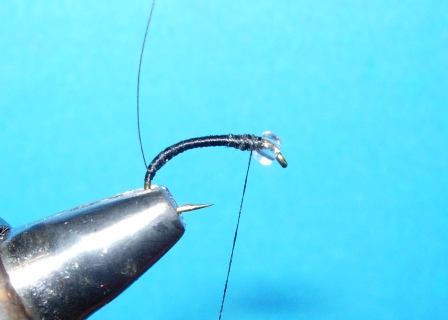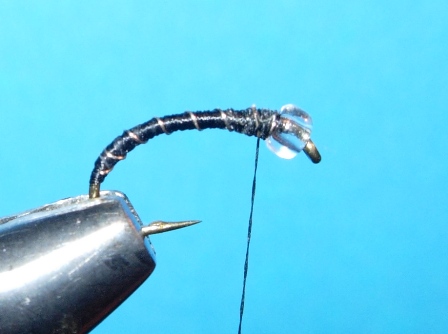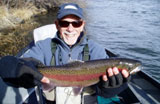Description
The Zebra Midge is my go-to midge pattern. It is typically
tied in black, but variations can include
red, silver, white, burnt orange and other
colors and hues. It is the ultimate in
simplicity, being composed of just a few
materials. With a bit of practice, it’s a
5-minute fly.
In the summer of 2007, Jim Holmes, Mike Howes, John Peterson
and I traveled up to eastern Oregon to fish
several streams there. Our plan was to stay
for 3 weeks or so—which we did. One of the
rivers we fished was the Owyhee, a beautiful
tailwater stream. We camped beside the upper
stretch of the river and fished four days on
the river. We caught a lot of very large
brown trout—but, strangely, no rainbows.
One afternoon we parked several miles downstream from our
camp area, to fish a section that we had not
tried. I wandered away, looking for some
good water upstream of the others. In an
area where the stream braided out, I tossed
my short line rig into a small pool in a
tiny side channel, beneath an overhanging
tree. The line stopped abruptly and I set
the hook. Thinking I was snagged I began to
try to loosen the flies from the bottom,
only to have the line and leader burst from
the pool. Stunned, I watched as the rig
swiftly ran downstream. Regaining my senses,
I put a little pressure on the fish, which I
had not yet seen. I was thinking “foul
hooked” but was secretly hoping it was a big
toad fair hooked. My minute or two fight
with the fish ended abruptly when it
(uncharacteristically, for a brown trout)
cleared the water in the tiny channel and
managed to beach itself on the sand and
cobble where it flopped about. I couldn’t
believe my eyes—was this the biggest brown
I’d ever “caught”?
Well, as it turns out, it was the second biggest—but I
cannot claim that I landed it because in
effect it landed itself. I yelled for John,
who was closest to me, but the downstream
cataract was too noisy and he didn’t hear
me. I slipped the hook from the fish’s
hooked old jaw and slid it back into the
stream, where it lazily swam off as if
nothing had happened. I, on the other hand,
was nearly a basket case, scratching my head
wondering why such a large specimen was
hanging out in that small pool in the tiny
side channel—and how truly lucky I was to
have had this odd experience. The fly,
incidentally, was a #18 Zebra Midge.
The standard pattern calls for a brass or copper bead at the
head. I prefer, however, a silver colored
glass bead—the kind that are clear but have
a silver lining in the hole. Let’s tie the
little imp using that bead.
Tying Instructions
(For best viewing: (1) Maximize
your Browser Window. (2) Type "Ctrl
+ or -" to enlarge or contract the
webpage display. (3) Use the
Horizontal and Vertical Scroll Bars
to scroll right and up/down to
display larger photos in your
browser)
|
-
Crimp the hook barb and place the bead
on the hook.
|

|
|
|
|
2.
Cover the hook shank with a
layer of thread, working from
the back of the bead to the hook
bend. The thread should extend
at least halfway down the bend.
3.
Tie in a piece of silver wire at
the point where the thread ends.
|
 |
|
|
|
4.
Wrap the thread back up the
shank to the back of the bead
and leave the bobbin there. Your
wraps should be smooth and even,
covering all gaps with no hook
surface showing.
5.
Wrap the ribbing material in
even turns up the shank and tie
it off behind the bead.
|
 |
|
|
|
6.
Place a tiny bit of dubbing on
the thread and dub a sparse
collar just behind the bead.
7.
Whip finish.
|
 |
|
|
|
|
Tying
Tips
1.
The two principal ways to fish
this fly on a stream are to put
it under an indicator rig, or
use it as a trailer or “stinger”
with about 16-20” of tippet
material tied off to the bend of
the main fly’s hook.
2.
When making the thread body,
create a nice smooth finish,
with no lumps or gaps.
Now, go tie one, and then go fish it, and…
|
|
|
|
|
 |
|

